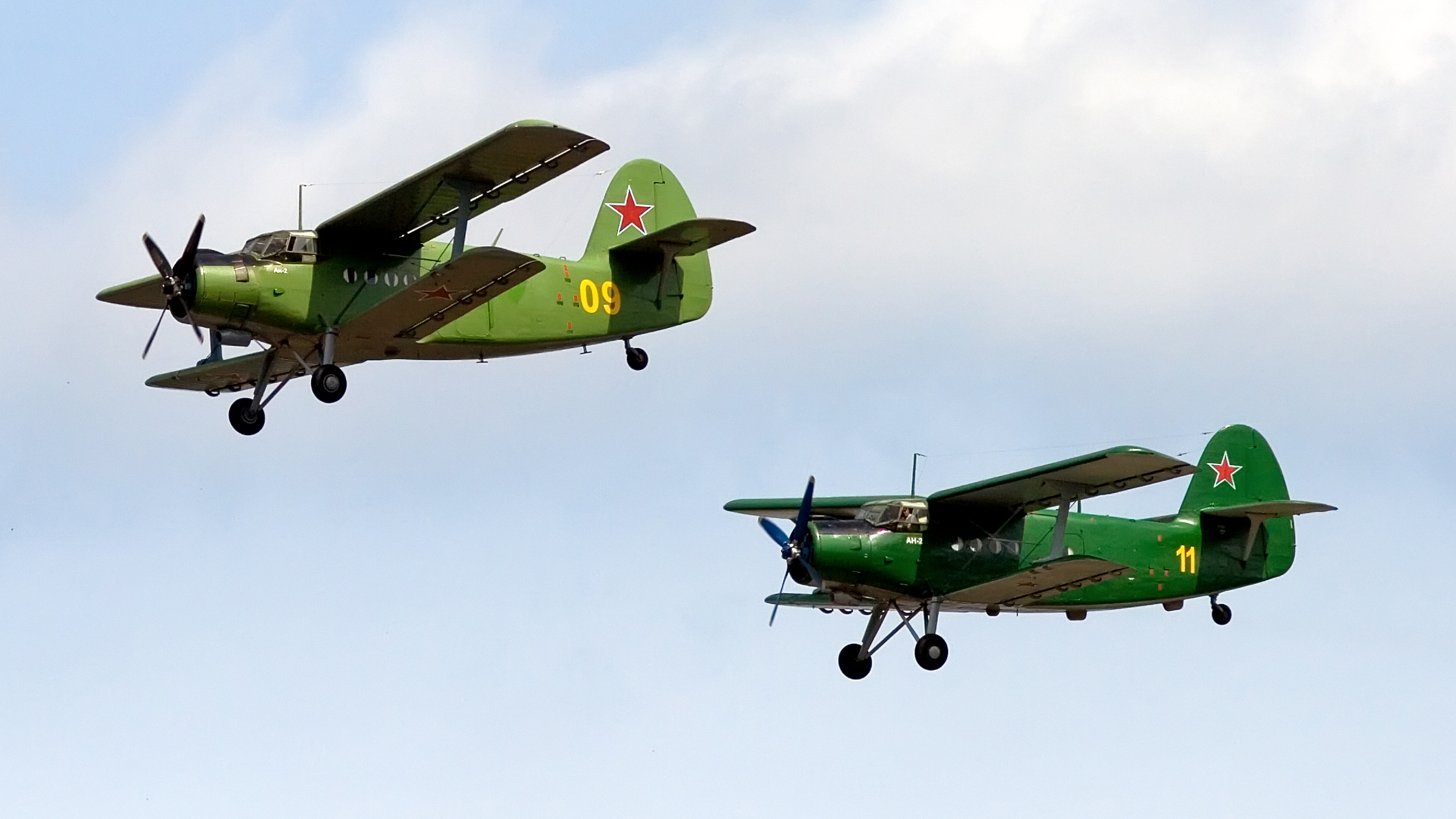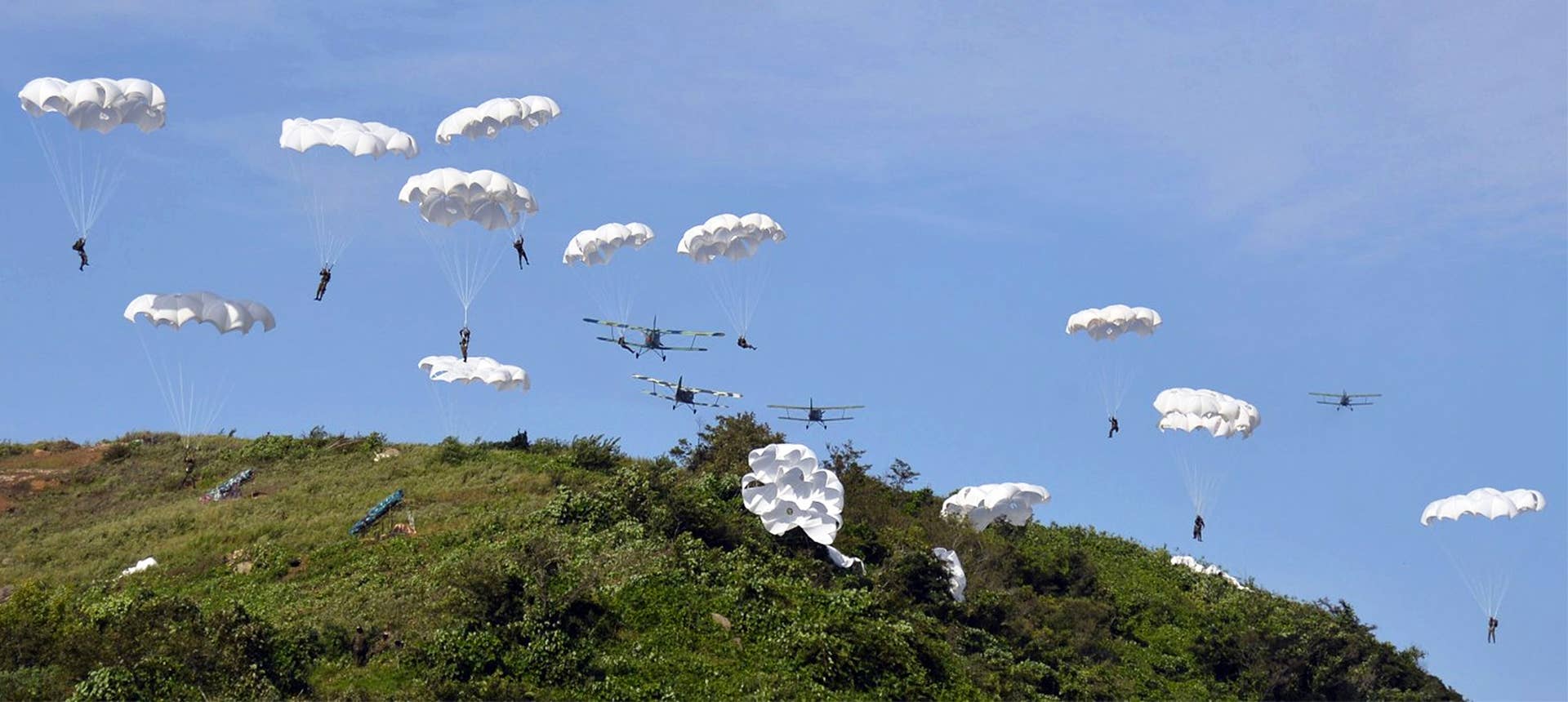While the air war in the first week of the Kremlin’s invasion of Ukraine has been dominated by apparent cruise missile strikes launched from bombers, extensive rotary-wing activity, and multiple, unconfirmed reports of air combat involving Russian and Ukrainian jets, one surprising participant looks to be waiting in the wings. The Russian Aerospace Forces’ (VKS) An-2 Colt biplane, a rugged, agricultural-looking design first flown in 1947, could well be getting ready for action over Ukraine, although the exact role it might fulfill remains puzzling.
Although designed primarily for crop-dusting, the An-2 proved to be a highly adaptable aircraft for both civilian and military operators. Even today it remains in frontline service both for various types of special operations work, including in an armed configuration. More commonly, however, it’s used as a training aircraft, especially for paratroopers.
Aerial imagery and accompanying analysis from the satellite imagery and space technology firm Maxar Technologies indicates that a considerable number of An-2s have now been moved to Seshcha Air Base in Bryansk Oblast, a region in western Russia, which shares a border to northern Ukraine.

Maxar satellite photos since February 28, which have been obtained by The Aviationist website, record 42 An-2s at the base, which is normally home to the 566th Military Transport Aviation Regiment (566 VTAP), operating the VKS fleet of giant An-124 Condor heavy transport aircraft. The regiment also flies a squadron of Il-76 Candid airlifters from the same base. The number of An-2s now there is significant, considering a total of around 60 thought to be in VKS service today.

The Colts can now also be seen arranged on the airbase’s unique layout, which includes a 10,000-foot runway that bisects the circular aircraft parking area.

The latest situation report from Maxar, also shared by The Aviationist, posits that the An-2s “have likely been converted to drones and could be used as decoys to simulate helicopter or UAV formations to draw out Ukraine’s air defenses.” This could also be related to the reported appearance of undisclosed electronic warfare aircraft that arrived at Seshcha in the middle of last month. Those aircraft could potentially be used together with the An-2s as part of a wider assault on Ukraine’s ground-based air defense network which has remained relatively intact against great odds.
That, however, is not confirmed and we don’t know for sure that Russia plans to use the An-2s in this way.
It’s also been reported that the VKS has been conducting sorties with its forward-deployed An-2s in proximity to the Ukrainian border, perhaps within the last month.
In a February 7 post, blogger Dylan Malyasov pointed to footage of nine An-2s in formation “in Russia’s border areas with Ukraine.”
Malyasov also suggested that the veteran aircraft would be used for “simulating a breakthrough of a helicopter group or attack drones,” basically serving as decoys to not only overwhelm Ukrainian defenses but potentially also to reveal the location of radar emitters that could then be hit by anti-radiation weapons, attacked with standoff munitions, or jammed with countermeasures.
Indeed, it seems it was this theory from Malyasov that led to the findings in the Maxar situation report. However, we don’t know for sure that the An-2s in the video were examples from Seshcha.
Either way, that report was apparently picked up by U.S. Senator Marco Rubio, the top Republican on the Senate Intelligence Committee, who also raised the prospect of Russia using the same 42 An-2s in an unmanned configuration:
Of course, using An-2s for this type of mission is not new. Indeed, it’s possible it could closely replicate the tactics employed by Azerbaijan during its war with Armenia in the region of Nagorno-Karabakh in 2020.
During that conflict, Azerbaijan rigged up An-2s with basic modifications to the flight controls. The biplanes were then flown by pilots and put on a course that would take them over the relevant Armenian positions. The pilot would then lock the controls and bail out, leaving it to fly pilotless, triggering the defenses before its ultimate demise, either shot down, running out of fuel, or otherwise crashing.
Footage reportedly showing an Azerbaijani An-2 shot down by Armenian air defenses:

It’s possible that there is already a precedent for Russia employing unmanned aircraft to probe or perhaps try and alert Ukrainian air defenses. Earlier today, the Ukrainian Ministry of Defense released a series of photos showing a Russian-made ENICS E95M pulse-jet target drone, the implication being it had been brought down, or at least recovered, by Ukrainian forces.
One role for this type of drone in the current conflict could be as some form of decoy or otherwise to reveal the presence of certain air defense systems. At this stage, it’s hard to say, but there is no record of this type of target drone in Ukrainian service.
As well as this apparent decoy drone, Russia could potentially convert a number of other drones for the role, as well. It also has other means of disrupting Ukrainian air defense systems, including tactical aircraft configured for defense suppression, standoff jamming platforms, and other electronic warfare means. Taken together, this suggests that the An-2 might not be envisaged for this specific mission. However, there’s at least one other possibility of how the An-2 could contribute to the ongoing Russian offensive.
It’s important to note that the type’s main role with the Russian Armed Forces nowadays is parachute training on behalf of the Airborne Troops, or VDV. Previously operated by the VDV itself, An-2s are now part of the VKS, which has several squadrons of the type, each with around 10 aircraft, at various different bases — but not normally at Seshcha.
This role reflects the fact that the An-2 is an ideal paratrooper platform — it’s even used for jump training by some NATO air forces. Moreover, paratrooping is a role that could also be undertaken in wartime.
Russian VKS paratroopers train with an An-2:

Indeed, depending on the progress of the Russian forces on the ground, the ability to deliver paratroopers relatively discretely from the air, while flying at low level, could be of particular use in assaults on key objectives, or encirclements. Notably, Seshcha is only around 250 miles away from Kyiv, the Ukrainian capital.

At the same time, the An-2s short takeoff and rough-field capabilities mean that it could also be used for insertion of troops close to other targets, whether to capture them or conduct sabotage, forward reconnaissance, or other covert missions.
In the past, we have looked specifically at the An-2’s wartime role with the North Korean military, which is widely expected to include delivering special forces troops directed against key targets in the South via low-level infiltration at night.

Such is the An-2’s potential for causing havoc in this way that South Korea has built up a fleet of these aircraft which are used as aggressors to train how best to defend against these tricky targets — after all, this is an aircraft for which the manual has no stall speed.
Flying low and slow, the An-2 would present a tricky target for Ukrainian air defenses, although there is no evidence that Russian Colts are armed with freefall bombs and rockets like their North Korean counterparts.
More importantly, the fabric-winged An-2 has a small radar cross-section for its size, which, coupled with its slow speed, makes it hard for enemy fighters to spot it using their radars. In fact, some air defense radars would be set to filter out such targets entirely. Meanwhile, its low-level capabilities, which can be implemented at night, mean traditional surface-to-air missile systems can struggle to detect and engage these aircraft.

Talking to The War Zone, Justin Bronk, a research fellow for airpower at the Royal United Services Institute (RUSI) judged it unlikely that the Russian An-2s would be used in some kind of defense-suppression scenario, but did point out that “they might be used to help alleviate some of the worst supply shortages at key points in the Russian advance caused by the ground forces appalling logistics failures.” Again, the type’s short- and rough-field performance would be very useful for this kind of work.
So, there are at least three different mission sets that the An-2 could feasibly undertake on behalf of Russia as its war in Ukraine grinds on. For now, we simply have no idea what the Russian military has planned for its forward-deployed Colts and it remains a possibility that these aircraft have moved to Seshcha for entirely unrelated reasons. Considering they are normally based on different airfields across Russia, that would seem less likely, however, pointing to the very real possibility that the Kremlin might commit the An-2 to battle a full 75 years after its first flight.
Contact the author: thomas@thedrive.com
